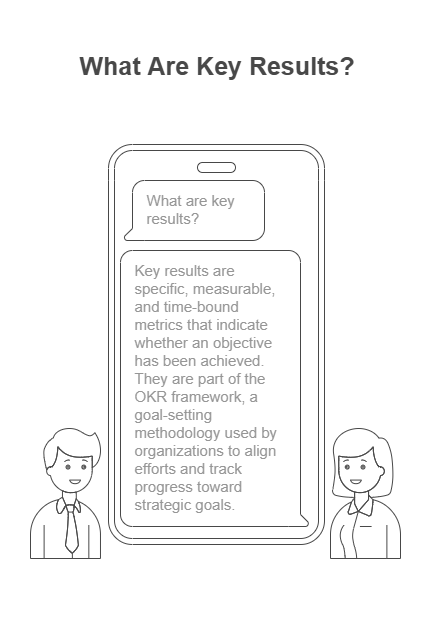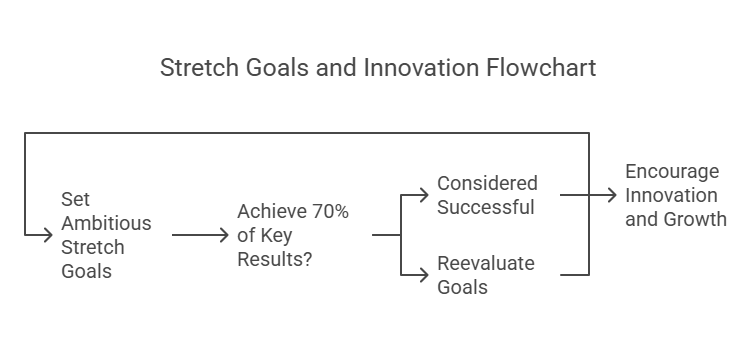
Ever wondered how top organizations turn ambitious goals into tangible outcomes? Enter Key Results—the measurable, action-oriented milestones that power the OKR (Objectives and Key Results) framework. Key Results bridge the gap between vision and reality, transforming high-level Objectives into specific, time-bound, and quantifiable outcomes. They answer the critical question: “How will we know we’ve succeeded?”
By setting clear Key Results, teams align efforts, track progress transparently, and hold themselves accountable to meaningful progress. Whether you’re aiming to boost performance, innovate, or scale impact, mastering Key Results ensures every step counts. Dive in to discover how to craft effective Key Results that propel your goals from aspiration to achievement.
Table of Contents
What Are Key Results?
Key results are specific, measurable, and time-bound metrics that indicate whether an objective has been achieved. They are part of the Objectives and Key Results (OKR) framework, a goal-setting methodology used by organizations to align efforts and track progress toward strategic goals.
Purpose and Importance
Key results help determine if a team is on track to meet its goals by providing quantifiable benchmarks. They ensure objectives are not vague but backed by concrete targets, fostering focus and accountability.
Surprising Detail: Stretch Goals
It’s surprising that achieving 70% of key results is often considered a success, encouraging ambitious, stretch goals rather than perfection, promoting innovation and growth.

Comprehensive Analysis of Key Results in the OKR Framework
This section provides an in-depth exploration of key results within the Objectives and Key Results (OKR) framework, detailing their definition, purpose, characteristics, best practices, examples, and common pitfalls. The analysis is grounded in recent research and practical applications, ensuring a thorough understanding for both practitioners and scholars.
Definition and Context
Key results are specific, measurable, and time-bound metrics designed to indicate whether an objective has been achieved. They are a critical component of the OKR framework, which was popularized by companies like Google and Intel, and is widely used across various industries for goal setting and performance management. The framework, attributed to Andrew Grove at Intel in the 1970s and documented in his 1983 book High Output Management, pairs qualitative objectives with quantitative key results to drive alignment and engagement.
Recent trends, as noted in 2025 statistics from Mooncamp, show an 11-fold increase in search volume for OKRs over the last decade, highlighting their growing acceptance. This surge is driven by the framework’s adaptability, now extending beyond businesses to non-profits, education, and personal goal setting, as seen in implementations for government clients in Singapore (OKR Asia).
Purpose and Role
The primary purpose of key results is to provide a mechanism for tracking and measuring progress toward objectives. They serve as benchmarks that allow organizations to assess whether they are on track to meet their goals, enabling timely adjustments. This is crucial in dynamic environments where market demands and internal priorities can shift rapidly, as emphasized in the Adapt Methodology guide for digital product leaders, which underscores OKRs’ role in fostering adaptability and reducing time-to-market.
Key results also enhance transparency and alignment, ensuring that all levels of an organization are working toward common outcomes. For instance, Asana notes that only 16% of knowledge workers feel their company effectively sets and communicates goals, underscoring the need for frameworks like OKRs to bridge this gap.
Characteristics of Effective Key Results
To be effective, key results must exhibit several characteristics:
- Measurable: They should be quantifiable, such as percentages, counts, or dollar amounts, ensuring no “grey area” in assessment, as per Wikipedia.
- Specific: Clarity is essential; for example, “Increase customer survey rating from 4 to 4.5” leaves no ambiguity.
- Time-bound: Typically aligned with quarterly cycles, key results have a defined timeframe, as advised by Weekdone Academy, which cautions against setting separate due dates for each key result, treating them as outcomes rather than milestones.
- Challenging: Key results should be set at a stretch level, encouraging ambition. Atlassian notes that scoring 0.7 on a key result is considered a success, promoting innovation over perfection.
- Aligned with the Objective: Each key result must directly contribute to the objective, ensuring that achieving them validates the objective’s success, as illustrated in What Matters examples.
Best Practices for Setting Key Results
Setting effective key results requires adherence to best practices to maximize impact:
- Align with the Objective: Ensure each key result is a meaningful contributor to the objective. For instance, if the objective is “Increase customer satisfaction,” key results should measure satisfaction metrics, not unrelated activities, as per Forbes Advisor.
- Outcome-Focused: Key results should measure impact, not output. Wikipedia cites Ben Lamorte’s advice to focus on outcomes (results) rather than output (work delivered), avoiding confusion with tasks.
- Limited in Number: Typically, 2 to 5 key results per objective maintain focus. Quantive recommends this range to avoid diluting efforts, aligning with Mooncamp examples.
- Regular Review and Adjustment: Key results should be reviewed quarterly, with adjustments made based on progress and changing conditions, as suggested by Psico-Smart, which advocates for continuous feedback mechanisms.
Examples and Application
To illustrate, consider the following examples, drawn from Quantive and What Matters:
| Objective | Key Results |
|---|---|
| Increase customer satisfaction | – Reduce customer complaint tickets by 20% in Q1 |
| – Increase customer survey rating from 4 to 4.5 | |
| – Achieve a net promoter score of 80 | |
| Improve team productivity | – Reduce average task completion time by 15% |
| – Increase projects completed on time by 25% | |
| – Decrease defects in deliverables by 30% |
These examples demonstrate how key results are specific, measurable, and time-bound, aligning with the objective’s intent. Atlassian provides scoring guidance, noting that a 0.3 score indicates missing the mark, while 1.0 signifies hitting the stretch target, reinforcing the stretch goal philosophy.
Common Mistakes to Avoid
Several pitfalls can undermine the effectiveness of key results:
- Confusing Key Results with Tasks: A common error is listing actions, such as “Install a new vendor package,” instead of outcomes, like “Reduce data errors by 10%,” as warned by Atlassian.
- Vague or Unmeasurable Key Results: Key results must be quantifiable; vague statements like “Improve customer service” lack measurability, as noted in Weekdone.
- Too Many Key Results: Overloading with key results can dilute focus, with Quantive advising against exceeding five per objective.
- Unrealistic Targets: While challenging, key results must be achievable. Setting unattainable goals can demotivate teams, as highlighted in What Matters, which suggests iterative learning from imperfect OKRs.
Recent Trends and Evolution
Key Points
The OKR framework continues to evolve, with trends in 2025 including continuous feedback mechanisms and integration with KPIs in traditional corporations, as per OKR Asia. Psico-Smart notes the shift toward quarterly reviews and adaptability, reflecting the framework’s agility in diverse ecosystems like The Gates Foundation.
- Key results are measurable targets in the OKR framework to track progress toward objectives.
- They should be specific, time-bound, and challenging but achievable.
- Typically, 2-5 key results per objective help maintain focus.
Conclusion
Key results are the backbone of the OKR framework, providing measurable benchmarks to track progress toward objectives. By adhering to best practices, avoiding common mistakes, and leveraging recent trends, organizations can effectively use key results to drive performance, align teams, and achieve ambitious goals. This comprehensive approach ensures that the OKR framework remains a powerful tool for strategic execution in 2025 and beyond.
